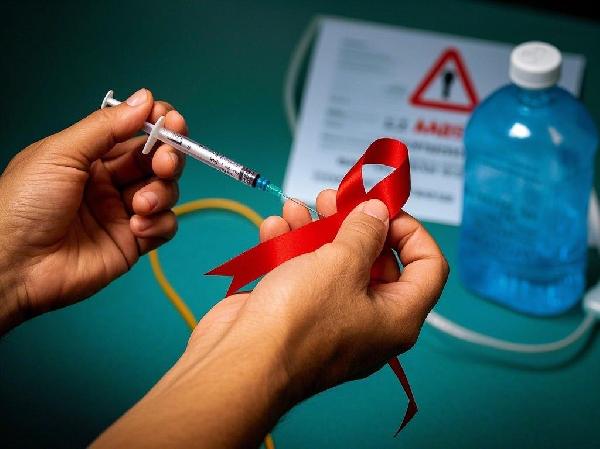AIDS is a highly dangerous infectious disease caused by the Human Immunodeficiency Virus (HIV). HIV is a virus that attacks the human immune system, primarily targeting the T-lymphocytes, which are the most important cells in the immune system. The virus destroys these cells in large numbers, leading to a loss of immune function. As a result, the body becomes highly susceptible to various diseases and can develop malignant tumors, with a high mortality rate. The average incubation period for HIV in the human body is 8 to 9 years, and individuals can live and work without any symptoms for many years before developing AIDS.

Where did AIDS originate?
Research suggests that AIDS originated in Africa and was later brought to the United States by immigrants. On June 5, 1981, the U.S. Centers for Disease Control and Prevention (CDC) published a report in the Morbidity and Mortality Weekly Report (MMWR) detailing five cases of AIDS patients, marking the first formal record of the disease in the world. In 1982, the disease was named "AIDS." Shortly thereafter, AIDS rapidly spread to all continents. In 1985, a foreign tourist visiting China fell ill and was admitted to Peking Union Medical College Hospital in Beijing, where he died shortly after. His death was later confirmed to be due to AIDS, marking the first recorded case of AIDS in China.
HIV-infected individuals may take several years, or even up to 10 years or more, before developing AIDS. Due to a severe decline in the body's resistance, they may experience various infections such as shingles, oral fungal infections, tuberculosis, enteritis caused by special pathogens, pneumonia, encephalitis, and severe infections caused by pathogens like Candida and Pneumocystis. In the later stages, malignant tumors often develop, leading to prolonged wasting and ultimately death from total physical exhaustion.
Despite tremendous efforts by medical researchers worldwide, there is still no cure for AIDS, nor is there an effective vaccine for prevention. AIDS has been classified as a Class B notifiable infectious disease in China and is also listed as a border health surveillance infectious disease.
How long can a person with AIDS live?
A healthy person infected with HIV generally goes through three stages before death. The first stage, known as the acute HIV infection stage, may cause flu-like symptoms such as fever, sore throat, rash, and swollen lymph nodes in some individuals. These symptoms usually disappear naturally within 2 to 3 weeks.
Next, the infected person enters the second stage, known as the asymptomatic period, which accounts for about 80% of the time from infection to death. During this stage, the infected person is called an HIV carrier. Most carriers appear healthy and indistinguishable from normal individuals, although their immune systems are engaged in an invisible battle with the virus.
HIV destroys a large number of immune cells daily, and the bone marrow compensates by accelerating the production of new cells. However, the rate of new cell production cannot keep up with the rate of cell loss. In a healthy person, there are about 800 to 1000 immune cells per cubic millimeter of blood, but in an infected person, this number decreases by 50 to 70 cells per year. When the number of immune cells drops to around 200 per cubic millimeter of blood, the rate of decline accelerates. The asymptomatic period can vary greatly, ranging from as little as 2 years to as long as 20 years, depending on the route of infection. Generally, those infected through blood (mainly through illegal blood collection and shared needles) have an asymptomatic period of 4 to 5 years, while those infected through sexual intercourse typically have a period of 11 to 13 years. If an infected person’s asymptomatic period reaches 13 years, they are considered a long-term survivor.
When the infected person’s immune cells can no longer fight against HIV, they enter the final stage of HIV infection, known as the symptomatic stage. At this point, the infected person is called an AIDS patient. They become highly susceptible to other infections, and common infectious diseases like pneumonia, which would not normally threaten a person’s life, can become uncontrollable in an AIDS patient. Death typically occurs within 6 to 24 months.
Experts say that AIDS patients may experience various complications, such as widespread skin herpes, meningitis, cancer, tuberculosis, and hepatitis. A man weighing over 100 pounds may lose weight to around 70 pounds, with sunken eyes, hair loss, muscle atrophy, difficulty breathing, and unbearable skin itching. Some may even develop dementia, lose their memory, and resemble a skeleton wrapped in skin before death.
To prevent AIDS, follow these steps:
1. Prevent sexual transmission of AIDS. Practice self-control and maintain a mutually monogamous sexual relationship; use condoms correctly during risky sexual activities; and seek timely treatment for sexually transmitted diseases.
2. Prevent blood transmission of AIDS. To prevent HIV transmission through blood, strong social prevention measures must be implemented, including the following key aspects:
(1) Ensure the safety of medical blood and blood products; further improve blood safety by promoting voluntary blood donation, minimizing or eliminating paid blood donation, and educating blood donors about the prevention of sexually transmitted diseases and AIDS to discourage people with high-risk behaviors from donating blood.
(2) Strictly control the indications for blood transfusion in medical practice, avoid using untested blood products, and reduce unnecessary blood transfusions, which are important measures to reduce HIV transmission through blood transfusion.
(3) Fully implement measures to prevent hospital infections, preventing the transmission of HIV in healthcare settings (including transmission from patients to medical staff, from patients to other patients, and from medical staff to patients).
(4) Personal preventive behaviors are also crucial in reducing the risk of HIV transmission through blood. Everyone should pay attention to the following: 1) Do not use other people's razors. 2) Avoid all forms of drug use, stay away from drugs, and especially do not use shared needles for drug injection.
3. Prevent mother-to-child transmission. HIV can be transmitted during pregnancy, childbirth, or through breastfeeding. HIV-infected women should avoid pregnancy, and if pregnant, should consider abortion. The use of antiviral drugs during pregnancy and childbirth can reduce the risk of mother-to-child transmission. Artificial feeding can also reduce the risk of HIV infection. Improving women’s nutrition, preventing anemia, treating infections, and preventing bleeding during and after pregnancy can reduce the need for unnecessary blood transfusions. HIV-infected women should avoid pregnancy, but if pregnant, they should use AZT or similar drugs during pregnancy, opt for a cesarean section, and avoid breastfeeding after delivery. Early diagnosis and regular treatment should be provided for newborns born to HIV-infected mothers.
4. Care for, assist, and do not discriminate against AIDS patients and HIV-infected individuals. Encouraging their participation in AIDS prevention and control efforts is an important aspect of preventing and controlling AIDS.
5. Contaminated waste can be incinerated. HIV itself is sensitive to heat and can be inactivated at 60°C for 60 minutes. Items that need to be reused can be disinfected by boiling or using high-pressure steam. Items that cannot be boiled can be soaked in glutaraldehyde, 75% alcohol, or other disinfectants. Bleach, sodium hypochlorite, and alcohol are commonly used for disinfecting contaminated environments and surfaces. Disinfectants used for hepatitis B can also be used for HIV disinfection.
























